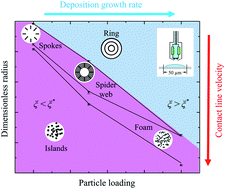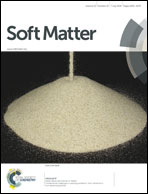From multi-ring to spider web and radial spoke: competition between the receding contact line and particle deposition in a drying colloidal drop†
Abstract
Deposition morphologies of inkjet-printed colloidal drops are examined under various drying conditions, particle volume fractions, and particle sizes. Concentric multi-rings, radial spokes, spider web, foam, and island-like depositions are observed as a result of the competition between the receding contact line and particle deposition during drop drying. Experimentally measured multi-ring spacing, δR, shows good agreement with the model predicted linear correlation with the local ring radius R. The results also show that the instability near the contact line leads to the radial spoke and saw-toothed structures. The resulting wavelength of the radial structures, λ, satisfies  and
and  , where RH is the relative humidity. A dimensionless parameter ξ, defined as the radial deposition growth rate to contact line velocity ratio, has been identified to determine the conditions under which the entire contact line can be pinned to leave a continuous ring deposit. Increasing the particle size while keeping the volume fraction the same is found to suppress the formation of the multi-ring deposition, due to a smaller number of particles available to pin the receding contact line.
, where RH is the relative humidity. A dimensionless parameter ξ, defined as the radial deposition growth rate to contact line velocity ratio, has been identified to determine the conditions under which the entire contact line can be pinned to leave a continuous ring deposit. Increasing the particle size while keeping the volume fraction the same is found to suppress the formation of the multi-ring deposition, due to a smaller number of particles available to pin the receding contact line.


 Please wait while we load your content...
Please wait while we load your content...